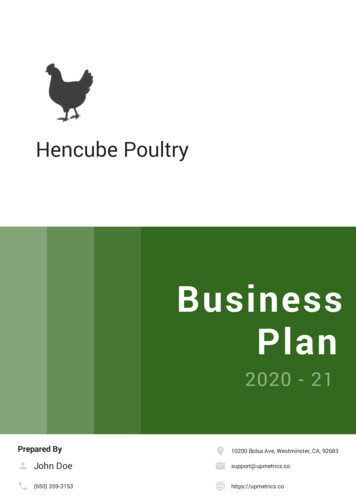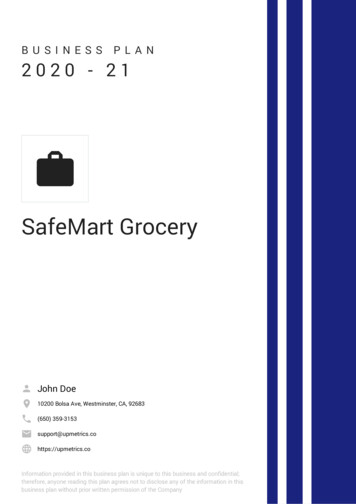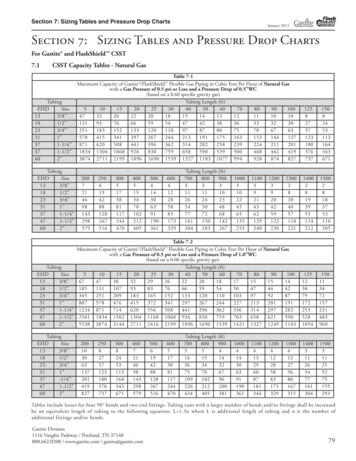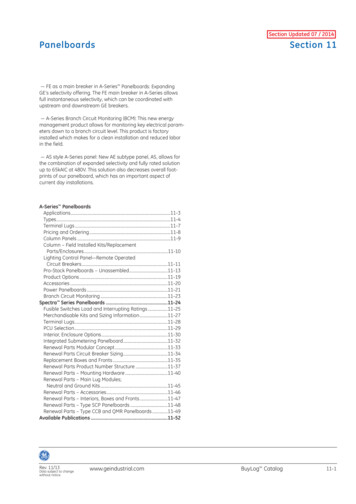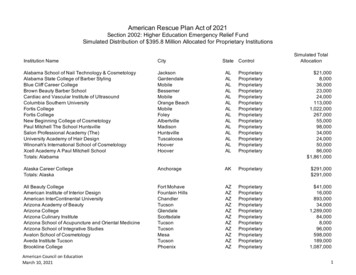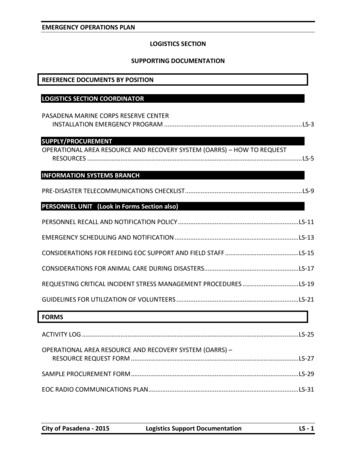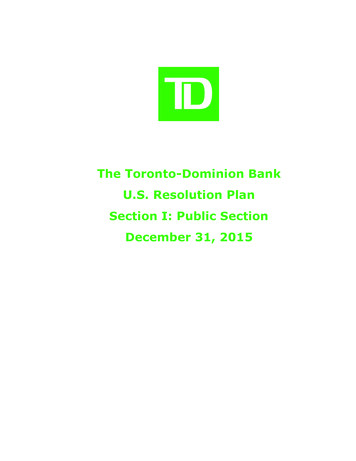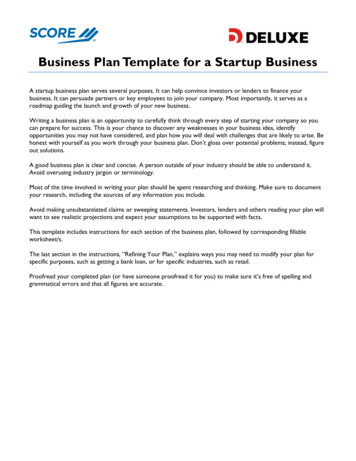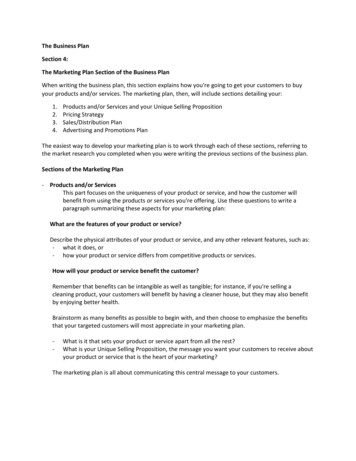
Transcription
The Business PlanSection 4:The Marketing Plan Section of the Business PlanWhen writing the business plan, this section explains how you're going to get your customers to buyyour products and/or services. The marketing plan, then, will include sections detailing your:1.2.3.4.Products and/or Services and your Unique Selling PropositionPricing StrategySales/Distribution PlanAdvertising and Promotions PlanThe easiest way to develop your marketing plan is to work through each of these sections, referring tothe market research you completed when you were writing the previous sections of the business plan.Sections of the Marketing Plan- Products and/or ServicesThis part focuses on the uniqueness of your product or service, and how the customer willbenefit from using the products or services you're offering. Use these questions to write aparagraph summarizing these aspects for your marketing plan:What are the features of your product or service?Describe the physical attributes of your product or service, and any other relevant features, such as:- what it does, or- how your product or service differs from competitive products or services.How will your product or service benefit the customer?Remember that benefits can be intangible as well as tangible; for instance, if you're selling acleaning product, your customers will benefit by having a cleaner house, but they may also benefitby enjoying better health.Brainstorm as many benefits as possible to begin with, and then choose to emphasize the benefitsthat your targeted customers will most appreciate in your marketing plan.-What is it that sets your product or service apart from all the rest?What is your Unique Selling Proposition, the message you want your customers to receive aboutyour product or service that is the heart of your marketing?The marketing plan is all about communicating this central message to your customers.
Pricing StrategyThe pricing strategy portion of the marketing plan involves determining how you will price yourproduct or service; the price you charge has to be competitive but still allow you to make areasonable profit.The keyword here is "reasonable"; you can charge any price you want to, but for every product orservice there's a limit to how much the consumer is willing to pay. Your pricing strategy needs totake this consumer threshold into account.The most common question small business people have about the pricing strategy section of themarketing plan is, "How do you know what price to charge?"-Basically, you set your pricing through a process of calculating your costs, estimating thebenefits to consumers, and comparing your products, services, and prices to others that aresimilar.Set your price by examining how much it cost you to produce the product or service and adding afair price for the benefits that the customer will enjoy.Examining what others are charging for similar products or services will guide you when you'refiguring out what a "fair" price for such benefits would be. You may find it useful to conduct aBreakeven Analysis.The pricing strategy you outline in your marketing plan will answer the following questions:1. What is the cost of your product or service?2. Make sure you include all your fixed and variable costs when you're calculating this;a. the cost of labor and materials are obvious, but you may also need to include freightcosts, administrative costs, and/or selling costs, for example.b. How does the pricing of your product or service compare to the market price of similarproducts or services?Explain how the pricing of your product or service is competitive.1. For instance, if the price you plan to charge is lower, why are you able to do this?2. If it's higher, why would your customer be willing to pay more?3. This is where the "strategy" part of the pricing strategy comes into play;a. Will your business be more competitive if you charge more, less, or the same as yourcompetitors and why?What kind of ROI (Return on Investment) are you expecting with this pricing strategy, and withinwhat time frame?
Sales and Distribution PlanRemember, the primary goal of the marketing plan is to get people to buy your products or services.The Sales and Distribution part of the marketing plan details how this is going to happen.Traditionally there are three parts to the Sales and Distribution section, although all three parts maynot apply to your business.Outline the distribution methods to be used.1. How is your product or service going to get to the customer?2. Will you distribute your product or service through a website, through the mail, through salesrepresentatives, or through retail?What distribution channel is going to be used?In a direct distribution channel, the product or service goes directly from the manufacturer to theconsumer. In a one stage distribution channel, it goes from manufacturer to retailer to consumer.The traditional distribution channel is from manufacturer to wholesaler to retailer to consumer.Outline all the different companies, people and/or technologies that will be involved in the processof getting your product or service to your customer.What are the costs associated with distribution?- These types of costs are different from production costs, which have to do with the actualprocess of creating the goods and services that are ultimately sold to customers. The range ofdistribution costs are often related to any expenses involving the transportation of finishedgoods from the manufacturer’s site as well as the costs of delivering the products to the buyers.In many instances, any costs incurred for storing the products between production andtransport are also considered distribution costs.-One of the more common examples of distribution costs has to do with transporting the goods.Transportation costs may focus on moving the finished goods from the production site to astorage facility where the goods remain in an inventory until they are used to fill customerorders. The costs may have to do with the maintenance of equipment to arrange the transport,or if a freight line or other carrier is used for the tasks, then the cost is usually accounted for asrelated to distribution.What are the delivery terms?-How will the distribution methods affect production time frames or delivery? (How long will ittake to get your product or service to your customer?)If your business involves selling a product- Include information about inventory levels and packaging in this part of your marketing plan.o How are your products to be packaged for shipping and for display?o Does the packaging meet all regulatory requirements (such as labelling)?o Is the packaging appropriately coded, priced, and complementary to the product?
oWhat minimum inventory levels must be maintained to ensure that there is no loss ofsales due to problems such as late shipments and back orders?Outline the transaction process between your business and your customers.1.2.3.4.5.6.7.8.What system will be used for processing orders, shipping, and billing?What methods of payment will customers be able to use?What credit terms will customers be offered?If you will offer discounts for early payment or impose penalties for late payment, they should bementioned in this part of your marketing plan.What is your return policy?What warranties will the customer be offered?a. Describe these or any other service guarantees.What after-sale support will you offer customers and what will you charge (if anything) for thissupport?Is there a system for customer feedback so customer satisfaction (or the lack of it) can be trackedand addressed?3) If it's applicable to your business, outline your sales strategy.What types of salespeople will be involved (commissioned salespeople, product demonstrators,telephone solicitors, etc.)?Describe your expectations of these salespeople and how sales effectiveness will be measured.Will a sales training program be offered? If so, describe it in this section of the marketing plan.Describe the incentives salespeople will be offered to encourage their achievements (such as gettingnew accounts, the most orders, etc.).Advertising and Promotion PlanEssentially the Advertising and Promotion section of the marketing plan describes how you're goingto deliver your Unique Selling Proposition to your prospective customers. While there are literallythousands of different promotion avenues available to you, what distinguishes a successful planfrom an unsuccessful one is the focus - and that's what your Unique Selling Proposition provides.So think first of the message that you want to send to your targeted audience. Then look at thesepromotion possibilities and decide which to emphasize in your marketing plan:Advertising - The best approach to advertising is to think of it in terms of media and which mediawill be most effective in reaching your target market. Then you can make decisions about how muchof your annual advertising budget you're going to spend on each medium.What percentage of your annual advertising budget will you invest in each of the following:the Internettelevisionradio
subway adsdirect mailcooperative advertising with wholesalers, retailers or other businesses?Include not only the cost of the advertising but your projections about how much business theadvertising will bring in.Sales Promotion - If it's appropriate to your business, you may want to incorporate salespromotional activities into your advertising and promotion plan, such as:offering free samplescouponsthe point of purchase displaysproduct demonstrationsMarketing Materials - Every business will include some of these in their promotion plans. The mostcommon marketing material is the business card, but brochures, pamphlets, and service sheets arealso common.Publicity - Another avenue of promotion that every business should use. Describe how you plan togenerate publicity. While press releases spring to mind, that's only one way to get people spreadingthe word about your business. Consider:product launchesspecial events, including community involvementwriting articlesgetting and using testimonialsFor more about publicity, see Getting Publicity for Your Business.Your Business's Website - If your business has or will have a website, describe how your website fitsinto your advertising and promotion plan. (Read How to Drive Traffic to Your Business Website first.)Tradeshows - Tradeshows can be incredibly effective promotion and sales opportunities - if you pickthe right ones and go equipped to put your promotion plan into action. Before You Attend ThatTrade Show explains how to choose appropriate trade shows. You'll also want to read: Tips For a Successful Trade Show How to Create an Effective Trade Show Display 27 Low-Cost Ways to Improve Your Next Trade Show
Other Promotion ActivitiesYour promotion activities are truly limited only by your imagination. Need inspiration?But If you plan to teach a course, sponsor a community event, or conduct an email campaign, you'llwant to include it in your advertising and promotion plan. Remember, sporadic unconnectedattempts to promote your product or service are bound to fail; your goal is to plan and carry out asequence of focused promotion activities that will communicate with your potential customers.While small businesses often have minuscule (or non-existent) promotion budgets, that doesn'tmean that small businesses can't design and implement effective promotion plans.No business is too small to have a marketing plan. After all, no business is too small for customers orclients. And if you have these, you need to communicate with them about your products and/orservices.
The Marketing Plan Section of the Business Plan When writing the business plan, this section explains how you're going to get your customers to buy your products and/or services. The marketing plan, then, will include sections detailing your: 1. Products and/or Services and your Unique Selling Proposition 2. Pricing Strategy 3. Sales/Distribution Plan 4. Advertising and Promotions Plan The .
